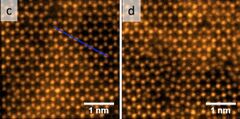Chemistry:Molybdenum diselenide

| |
 Top-view atomic images of MoSe2 before and after (right) ion irradiation[1]
| |
| Names | |
|---|---|
| IUPAC name
bis(selanylidene)molybdenum
| |
| Other names
molybdenum diselenide, molybdenumdiselenide, molybdenum selenide, diselanylidenemolybdenum, molybdenum(IV) selenide
| |
| Identifiers | |
3D model (JSmol)
|
|
PubChem CID
|
|
| |
| Properties | |
| MoSe2 | |
| Molar mass | 253.86 g/mol[2] |
| Appearance | crystalline solid |
| Density | 6.90 g/cm3[2] |
| Melting point | >1200 °C[2] |
| Band gap | ~0.85 eV (indirect, bulk) ~1.5 eV (direct, monolayer)[3][4] |
| Structure | |
| hP6, space group P63/mmc, No 194[5] | |
a = 0.3283 nm, c = 1.2918 nm
| |
| Trigonal prismatic (MoIV) Pyramidal (Se2−) | |
| Related compounds | |
Other anions
|
Molybdenum dioxide Molybdenum disulfide Molybdenum ditelluride Tantalum diselenide |
Other cations
|
Tungsten diselenide |
Except where otherwise noted, data are given for materials in their standard state (at 25 °C [77 °F], 100 kPa). | |
| Infobox references | |
Molybdenum diselenide (MoSe2) is an inorganic compound of molybdenum and selenium. Its structure is similar to that of MoS2.[6] Compounds of this category are known as transition metal dichalcogenides, abbreviated TMDCs. These compounds, as the name suggests, are made up of a transition metals and elements of group 16 on the periodic table of the elements. Compared to MoS2, MoSe2 exhibits higher electrical conductivity.[7]
Structure
Like many TMDCs, MoSe2 is a layered material with strong in-plane bonding and weak out-of-plane interactions. These interactions lead to exfoliation into two-dimensional layers of single unit cell thickness.[8]
The most common form of these TMDCs have trilayers of molybdenum sandwiched between selenium ions causing a trigonal prismatic metal bonding coordination, but it is octahedral when the compound is exfoliated. The metal ion in these compounds is surrounded by six Se2− ions. The coordination geometry of the Mo is sometimes found as octahedral and trigonal prismatic.[9]
Synthesis
Synthesis of MoSe2 involves direct reaction of molybdenum and selenium in a sealed tube at high temperature. Chemical vapor transport with a halogen (usually bromine or iodine) is used to purify the compound at very low pressure (less than 10-6 torr) and very high temperature (600–700 °C). It has to be heated very gradually to prevent explosion due to its strong exothermic reaction. Stoichiometric layers crystallize in a hexagonal structure as the sample cools.[9] Excess selenium can be removed by sublimation under vacuum.[10] The synthesis reaction of MoSe2 is:
- Mo + 2 Se → MoSe2
2D-MoSe2
Single-crystal-thick layers of MoSe2 are produced by scotch tape exfoliation from bulk crystals or by chemical vapor deposition (CVD).[11][12]
The electron mobility of 2D-MoSe2 is significantly higher than that of 2D-MoS2. 2D MoSe2 adopts structures reminiscent of graphene, although the latter's electron mobility is thousands of times greater still. In contrast to graphene, 2D-MoSe2 has a direct band gap, suggesting applications in transistors and photodetectors.[11]
Natural occurrence
Molybdenum(IV) selenide occurs in the nature as the extremely rare mineral drysdallite.[13]
References
- ↑ Iberi, Vighter; Liang, Liangbo; Ievlev, Anton V.; Stanford, Michael G.; Lin, Ming-Wei; Li, Xufan; Mahjouri-Samani, Masoud; Jesse, Stephen et al. (2016). "Nanoforging Single Layer MoSe2 Through Defect Engineering with Focused Helium Ion Beams". Scientific Reports 6: 30481. doi:10.1038/srep30481. PMID 27480346. Bibcode: 2016NatSR...630481I.
- ↑ Jump up to: 2.0 2.1 2.2 Haynes, William M., ed (2011). CRC Handbook of Chemistry and Physics (92nd ed.). Boca Raton, FL: CRC Press. p. 4.76. ISBN 1439855110.
- ↑ Yun, Won Seok; Han, S. W.; Hong, Soon Cheol; Kim, In Gee; Lee, J. D. (2012). "Thickness and strain effects on electronic structures of transition metal dichalcogenides: 2H-MX2 semiconductors (M = Mo, W; X = S, Se, Te)". Physical Review B 85 (3): 033305. doi:10.1103/PhysRevB.85.033305. Bibcode: 2012PhRvB..85c3305Y.
- ↑ Kioseoglou, G.; Hanbicki, A. T.; Currie, M.; Friedman, A. L.; Jonker, B. T. (2016). "Optical polarization and intervalley scattering in single layers of MoS2 and MoSe2". Scientific Reports 6: 25041. doi:10.1038/srep25041. PMID 27112195. Bibcode: 2016NatSR...625041K.
- ↑ Agarwal, M. K.; Patel, P. D.; Joshi, R. M. (1986). "Growth conditions and structural characterization of MoSexTe2−x (0 ⩽ x ⩽ 2) single crystals". Journal of Materials Science Letters 5: 66–68. doi:10.1007/BF01671439.
- ↑ Greenwood, N. N.; Earnshaw, A. (11 November 1997). Chemistry of the Elements. Elsevier. pp. 1017–1018. ISBN 978-0-08-050109-3. https://books.google.com/books?id=EvTI-ouH3SsC.
- ↑ Eftekhari, Ali (2017). "Molybdenum Diselenide (MoSe2) for Energy Storage, Catalysis, and Optoelectronics". Applied Materials Today 8: 1–16. doi:10.1016/j.apmt.2017.01.006.
- ↑ Wang, Qing Hua; Kalantar-Zadeh, Kourosh; Kis, Andras; Coleman, Jonathan N.; Strano, Michael S. (2012). "Electronics and optoelectronics of two-dimensional transition metal dichalcogenides". Nature Nanotechnology 7 (11): 699–712. doi:10.1038/nnano.2012.193. PMID 23132225. Bibcode: 2012NatNa...7..699W. http://infoscience.epfl.ch/record/182177.
- ↑ Jump up to: 9.0 9.1 Parilla, P.; Dillon, A.; Parkinson, B.; Jones, K.; Alleman, J.; Riker, G.; Ginley, D.; Heben, M; Formation of Nanooctahedra in Molybdenum Disulfide and Molybdenum Diselenide Using Pulsed Vapor Transport doi:10.1021/jp036202
- ↑ Al-hilli, A.; Evans, L. The Preparation and Properties of Transition Metal Dichalcogenide Single Crystals. Journal of Crystal Growth. 1972. 15, 93–101. doi:10.1016/0022-0248(72)90129-7
- ↑ Jump up to: 11.0 11.1 "Scalable CVD process for making 2-D molybdenum diselenide". Rdmag.com. 2014-04-04. http://www.rdmag.com/news/2014/04/scalable-cvd-process-making-2-d-molybdenum-diselenide. Retrieved 2014-04-09.
- ↑ Choi, H. M. T.; Beck, V. A.; Pierce, N. A. (2014). "Next-Generation in Situ Hybridization Chain Reaction: Higher Gain, Lower Cost, Greater Durability". ACS Nano 8 (5): 4284–94. doi:10.1021/nn405717p. PMID 24712299.
- ↑ "Home". http://www.mindat.org/.
 |

